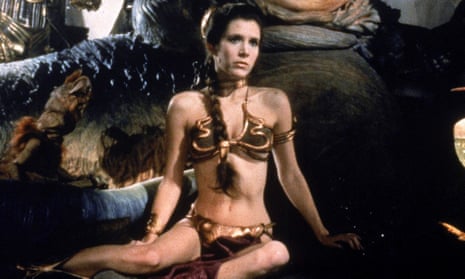Mutter the phrase “slave Leia” and unless you’ve been living under a rock since 1983, you’ll probably get a mental image of Carrie Fisher in a golden bikini chained to a giant slug.
It’s one of the most memorable, weird, gross and resonant moments from The Return of the Jedi, and from Star Wars in general – and Disney is working to disavow it. The company is rumored to be retiring their slave Leia figurine – a move which has prompted commenters on social media to declare “good riddance”. Writer Mariah Heuhner tweeted: “Even before I knew what sexual objectification was, the Leia/bikini thing made me really uncomfortable as a kid.” Carrie Fisher herself criticized the outfit, warning new Star Wars actor Daisy Ridley: “Don’t be a slave like I was … You keep fighting against that slave outfit.”
It’s easy to see why Fisher isn’t fond of the get-up. The sequence with the giant bloated Jabba the Hut is a not-even-concealed Orientalist harem fantasy, complete with desert, chuckling dissipated bloated pasha and hapless princess decked out in fetishwear and chains. The sequence is a bit of soft-core porn dropped in the middle of a kids’ adventure story. Through the rest of the series (with the possible exception of A New Hope’s torture sequence) Leia is irascible, tough, empowered and, notably, completely covered. Then, all of a sudden, she’s a vulnerable, objectified sex toy. The dissonance is startling and stomach-churning.
Obviously, a good part of the motivation for the slave Leia costume had to have been fan-service. The outfit caters both to hormonal pubescents, for whom Princess Leia was already a sex symbol, and to Lucas’s love affair with all those old adventure serials, with Leia playing Dale Arden, and Jabba as Ming the Merciless.
But the slave sequence also fits oddly, but definitively, into Leia’s character arc. Remember that at the end of the Empire Strikes Back, before he’s placed in cold storage, Leia kisses Han and says, “I love you.” To which Harrison Ford famously ad libs, “I know.”
This is the moment when, as Tricia Barr writes, Leia changes “from devoted champion of the Rebellion, to a woman on a mission to save her man”. But it’s also, and not coincidentally, the moment when Leia acknowledges her own sexuality and her own desires – desires which were visible to that worldly-wise, not-nice Han, but not to her.
In a romance, the declaration of love would lead directly to bliss and the conclusion of the narrative. But Star Wars isn’t a romance, and true love leads not to marriage and happily ever after, but to a manically gendered mess. At the beginning of Return of the Jedi, Leia, who up to this point has mostly been dressed in utilitarian but recognizably female attire, suddenly starts switching wardrobes. First she disguises herself as the male bounty hunter Boushh. Then she switches to the sexed-up slave bikini.
According to the narrative, Leia dresses as a man to fool Jabba and rescue Han, and then dresses in the bikini because she’s forced to by Jabba. But you could also see the story as a sublimated reaction to Leia’s emotional and sexual awakening. Having suddenly discovered her own desires, she has to fit them into her own conception of her own gender.
And so she tries on different outfits. To love Han, should she be a man like Han: brave, dashing, reckless? Or should she be a gratuitous, over-the-top male fantasy? Does Han want a comrade? Does he want a slave? She knew who she was before she loved him, but who she is now is less clear. Leia may want to be the person Han knows, whoever that is, but she may also want to be someone else.
Leia rejects the slave identity emphatically; as critic Vom Marlowe puts it, she “strangles Jabba the Hutt with the literal chains of the patriarchy”. Those patriarchal chains aren’t just patriarchal chains, though; they’re also a BDSM fever dream. The specter of adult relationships and adult sexuality causes Lucas, and his film, to freak out, erupting in a cacophony of fetishes: bondage, submission, Orientalism, tentacle sex and rape fantasy. Leia is objectified – but as the woman seeking to free her man, and as the fascinating protagonist running through different outfits and different identities, she’s also the driving subject of the narrative, in a way she almost never is for the rest of the Han-and-Luke focused series.
Slave Leia fascinates the fandom because of sex. But I don’t think it’s just sex. Luke may be leaping around with his lightsaber in the foreground, but the backdrop of the Jabba arc is the Han and Leia romance. What would you do for love? What do you want to do, and who do you want to be, for love? The slave-Leia approach to these issues is clumsy and sexist, but the questions themselves are neither of those things. Almost by accident, Star Wars stumbled briefly into material with some consequence. Which is perhaps why Disney has decided to back away.

Comments (…)
Sign in or create your Guardian account to join the discussion